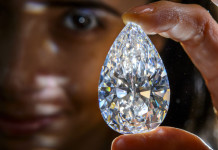
WHEN three of South Africa’s wealthiest families engage in some discreet business dealings, it’s perhaps worth taking a second look. In September last year, Christo Wiese sold his 13.72% stake in Gemfields, a Johannesburg- and London-listed mining business founded by mining supremo Brian Gilbertson and now run by his son, Sean. The buyer was Assore, an investment company owned by the octogenarian geologist Des Sacco whose father, Guido, was a founder of South Africa’s manganese fields, dating back to the 1920s.
What, though, is Assore doing establishing a beachhead in Gemfields, an investment it has since extended to 26.6%? Gemfields has been uneven in performance in the past and operates in the arcane world of emerald and ruby mining. In fact, when you think about it, coloured gemstones are about as far removed from Assore’s core business of bulk mining manganese and iron ore as can be found in the resources sector.
Gemfields’ assets are also relatively far-flung compared to Assore’s South African footprint, which, in mineral resource terms, is familiar territory, having been established generations ago. The market is also fairly secure, with supply deficits forecast for iron ore and manganese, albeit over differing timelines. In contrast, Gemfields’ rubies are mined at Montepuez in northern Mozambique, close to Cabo Delgado, which in 2020 were attacked by jihadist insurrectionists. Then there’s the opacity of the coloured gemstone market, of which more later.
Kieran Daly, head of Assore’s strategy, refers inquiries to Gemfields CEO Sean Gilbertson. Assore was never an especially voluble company, even when it was JSE-listed. Since going private in 2020, it is less inclined to make public pronouncements. Luckily, Gilbertson speaks openly, and persuasively.
“We are very much graduating from a junior miner to a mid-level miner both in terms of scale of mining and revenues. We’ve very recently gone through $250m in revenue, and we’re keen to grow that. This is what Assore sees,” said Gilbertson in an interview with the Financial Mail’s Investors’ Monthly.
Already, Assore’s bet is paying off. Wiese’s tranche of shares was sold when Gemfields was hovering around 13 pence/share. Its shares in London are around 16p apiece, and could reach 25p, according to the UK-based investment firms, Liberum and finnCap.
In the last 12 months, shares in Gemfields have been 24% higher, although that needs to be seen in the context of 2020, when the firm nearly lost its shirt. Covid-related travel restrictions stopped gemstone auctions for a year. Consequently, Gemfields cut staff and executive salaries, closed Montepuez and Kagem, its Zambian emerald mine, and then prayed. Thankfully, Gemfields avoided having to ask shareholders for cash but it was a close call, says Gilbertson. He recently described 2020 as “grisly”.
Clearly, that is all blood under the bridge. Liberum analysts Ben Davis, Tom Price and Yuen Low say Gemfields has “bounced back stronger than ever”. Free cash flow totalled $118m for the 12 months ended December while the balance sheet had been “fully repaired”, with net cash of $62m. On top of that, Gemfields delivered a maiden 1.7 US cents per share dividend. While there’s no payout policy in place yet, at 7.3%, Gemfields has the highest yield of the gem miners.
The question, though, is where Assore goes from here with Gemfields. “Assore is the single largest shareholder in Gemfields and at a 30% stake it would trigger a mandatory offer to shareholders [in terms of UK takeover regulations],” says Gilbertson. “I don’t believe Assore has any intention of doing that.”
Rather, Gemfields is one piece in Assore’s investment plan post going private. Had Assore’s “off-piste” investment in Gemfields been taken a couple of years ago while listed, it would have raised a few eyebrows, Gilbertson acknowledges. Now, though, it appears to be the Assore strategy: it has, for instance, a similar-sized minority stake in UK-listed Atlantic Lithium, an exploration firm.
“What we’ve seen so far from Assore is a desire to work together,” says Gilbertson. There’s also been a technology and ‘how-to’ exchange in the engineering and mining departments. That’s important as Gemfields is on the cusp of expansion. An increase in ruby production at Montepuez is planned, with a second washplant to be commissioned around the first quarter of 2023. All in all, some $50m in capex is planned for Gemfields’ 2022 financial year. Based on the current trajectory of ruby prices, and with increased volumes on the horizon, revenue could march through $300m in two to three years’ time, says Charlie Long at finnCap.
Assore also represents an anchor shareholder for Gemfields, potentially ending two years of acrimonious shareholder relations. This relationship was largely driven by the activist shareholder, Groundswell, and the Le Roux family of Capitec fame via Rational Expectations, which still holds 9% in Gemfields. Gilbertson likens a recent entente between the sides as a “truth and reconciliation” moment. One bone of contention that Groundswell catalysed was a long-standing disaffection among Gemfields shareholders to the firm’s executive pay. Its remuneration report hasn’t received more than 75% of the vote for the past four years, although it nearly passed muster in 2021.
There’s no magic pixie dust we can sprinkle. It’s just hard work done with a shovel
Among the disaffected are remnant shareholders in Gemfields’ predecessor, Pallinghurst Resources, the investment fund listed by Brian Gilbertson on the JSE in 2007 for R10/share, a valuation never to be scaled again. One might blame the 2008 global financial crisis for Pallinghurst’s poor start to life, but Pallinghurst shareholders have tended to blame the Gilbertsons. Investec and EMG Investments, a Washington investor, left the stock in 2017 around the time Pallinghurst was closed and restructured, with Gemfields being the outcome.
Pallinghurst was long dogged by a significant discount to NAV. That’s still a reality for Gemfields but it’s narrowed, says Gilbertson. “There’s no magic pixie dust we can sprinkle. It’s just hard work done with a shovel,” he says of one day winning market confidence. Again, you can see why Assore espied a window of opportunity.
A less tangible factor, but possibly critical in Assore’s Gemfields investment, is to do with the feelings of romance only miners can have towards insensate rock. “We appealed to their eyes and their heart,” says Gilbertson of the Sacco family’s passion for all forms of geology. Des Sacco’s personal collection of more than 3,500 mineral specimens has been curated and includes such curiosities as pyrophyllite, a mineral with reputed mystical powers. Mined at the Wonderstone mine near Ottosdal in North West province, it’s one example of why Gilbertson describes Sacco as “an eager collector”.
Unwieldy market
As for rubies and emeralds and other coloured gemstones, such as sapphires, the first thing to know is that their marketplace is decidedly unsubtle compared to any other luxury goods. The diamond industry, for example, has a multitude of suppliers, dealers and traders and owing to time-honoured pricing points, a degree of value standardisation. That simply doesn’t exist in coloured gemstones.
Take, for instance, a top-of-the-range Mercedes Benz, which is estimated to be roughly 10 times the price of an entry-level model of say €30,000. But in gemstones, the difference between the top and lowest is an estimated 30 million times per carat. “I’ve been in the industry for years and it’s still hard to get my head around that one,” says Gilbertson. “The coloured gemstones market is still a baby.”
That makes getting a fair price potentially tricky. Valuing coloured gemstones at the point of export is possible, but unwise, he says. “You’re screwed because no customs official has expertise to set a price.” In this there’s opportunity for Gemfields because in installing pricing order, it can also cement its market leadership. This it attempts by putting a placeholder price on goods at point of origin in a process that is government-monitored. Then Gemfields procures a market price from buyers, taking the best and withholding stones it can’t reasonably dispatch.
The diamond industry, for example, has a multitude of suppliers, dealers and traders and owing to time-honoured pricing points, a degree of value standardisation. That simply doesn’t exist in coloured gemstones.
A related risk of the evolving gemstone market is the challenge of establishing provenance – something the diamond industry has only recently achieved. In the coloured gemstone market, however, this is still problematic. In 10 years of government data, Gemfields’ Montepuez mine – which has been operating for only seven of those years – comprises about 94% of total ruby, emerald and sapphire sales from Mozambique. “I find it disgusting, depressing and illuminating, but at least it shows gem sales have just evaporated from the continent.”
All these factors shout opportunity to investors provided Gemfields can reliably produce its stones, control its costs and ethically exploit a developing market. But there are some rough edges still in Gemfields. One is its investment in Fabergé, the historic Russian family jewellery brand once repurposed by Unilever to sell aftershave. A serial lossmaker in the past, Gilbertson refuses to make it a marketing cost and says the tide has turned for the brand.
Another issue is Gemfields’ stake in Sedibelo Platinum Mines, which had precious metals as part of its then offering and represents a throwback to the Pallinghurst Resources days. Since Gemfields relisted in London, the Sedibelo stake has been locked up in structure. Eventually, there is light at the end of the tunnel. A demerger last year now means Gemfields has a direct 6.5% stake in the firm that it can now sell once Sedibelo Platinum Mines lists, possibly later this year.
Gilbertson confirms proceeds will be returned to shareholders. If this can be achieved, along with a dividend policy, Gemfields might forge a new path.
This article first appeared in The Mining Yearbook 2022 which can be accessed free of charge here >>











